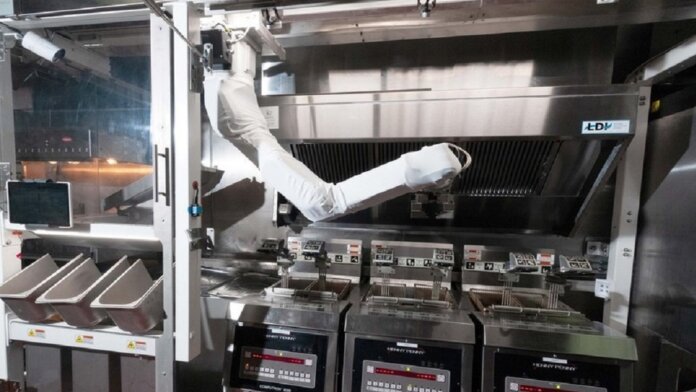Four and a half years ago, a robot named Flippy made its burger-cooking debut at a fast food restaurant called CaliBurger. The bot consisted of a cart on wheels with an extending arm, complete with a pneumatic pump that let the machine swap between tools: tongs, scrapers, and spatulas. Flippy’s main jobs were pulling raw patties from a stack and placing them on the grill, tracking each burger’s cook time and temperature, and transferring cooked burgers to a plate.
This initial iteration of the fast-food robot—or robotic kitchen assistant, as its creators called it—was so successful that a commercial version launched last year. Its maker Miso Robotics put Flippy on the market for $30,000, and the bot was no longer limited to just flipping burgers; the new and improved Flippy could cook 19 different foods, including chicken wings, onion rings, french fries, and the Impossible Burger. It got sleeker, too: rather than sitting on a wheeled cart, the new Flippy was a “robot on a rail,” with the rail located along the hood of restaurant stoves.
This week, Miso Robotics announced an even newer, more improved Flippy robot called Flippy 2 (hey, they’re consistent). Most of the updates and improvements on the new bot are based on feedback the company received from restaurant chain White Castle, the first big restaurant chain to go all-in on the original Flippy.
So how is Flippy 2 different? The new robot can do the work of an entire fry station without any human assistance, and can do more than double the number of food preparation tasks its older sibling could do, including filling, emptying, and returning fry baskets.
These capabilities have made the robot more independent, eliminating the need for a human employee to step in at the beginning or end of the cooking process. When foods are placed in fry bins, the robot’s AI vision identifies the food, picks it up, and cooks it in a fry basket designated for that food specifically (i.e., onion rings won’t be cooked in the same basket as fish sticks). When cooking is complete, Flippy 2 moves the ready-to-go items to a hot-holding area.
Miso Robotics says the new robot’s throughput is 30 percent higher than that of its predecessor, which adds up to around 60 baskets of fried food per hour. So much fried food. Luckily, Americans can’t get enough fried food, in general and especially as the pandemic drags on. Even more importantly, the current labor shortages we’re seeing mean restaurant chains can’t hire enough people to cook fried food, making automated tools like Flippy not only helpful, but necessary.
“Since Flippy’s inception, our goal has always been to provide a customizable solution that can function harmoniously with any kitchen and without disruption,” said Mike Bell, CEO of Miso Robotics. “Flippy 2 has more than 120 configurations built into its technology and is the only robotic fry station currently being produced at scale.”
At the beginning of the pandemic, many foresaw that Covid-19 would push us into quicker adoption of many technologies that were already on the horizon, with automation of repetitive tasks being high on the list. They were right, and we’ve been lucky to have tools like Zoom to keep us collaborating and Flippy to keep us eating fast food (to whatever extent you consider eating fast food an essential activity; I mean, you can’t cook every day). Now if only there was a tech fix for inflation and housing shortages…
Seeing as how there’ve been three different versions of Flippy rolled out in the last four and a half years, there are doubtless more iterations coming, each with new skills and improved technology. But the burger robot is just one of many new developments in automation of food preparation and delivery. Take this pizzeria in Paris: there are no humans involved in the cooking, ordering, or pick-up process at all. And just this week, IBM and McDonald’s announced a collaboration to create drive-through lanes run by AI.
So it may not be long before you can order a meal from one computer, have that meal cooked by another computer, then have it delivered to your home or waiting vehicle by a third—you guessed it—computer.
Image Credit: Miso Robotics



